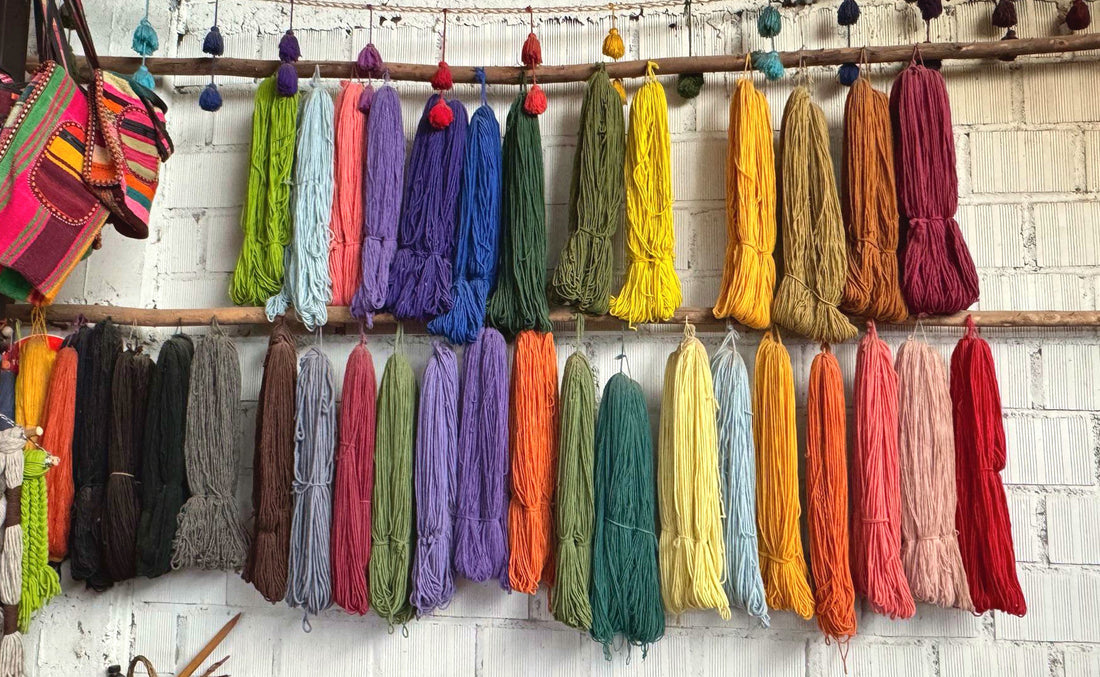
How is alpaca wool coloured?
Share
How is alpaca wool coloured?
Alpaca wool, being a mostly hand-crafted fibre, is dyed with totally natural methods, using plants and elements readily available in nature. The colours can be of various shades, but they all derive from 7 main colour groups:
Green and Blue
"Chilca", or scientifically called “Baccharis Latifolia” which is a plant from South America, is mixed with indigo and its result is used to dye alpaca fibre green. In some areas, Eucalyptus leaves are also used for lighter green tones (see photo).
"Alpaca wool and Eucalyptus"
Purple and Lilac
Alpaca wool with purple, lilac and bluish tones is treated with “Maiz Morado”, i.e. purple maize. This type of maize is not only used for dyeing alpaca fibre, but is also used in the culinary sector for the preparation of various dishes and even drinks.
"Alpaca wool and Maiz Morado"
Grey and Black
Alpaca fibre with grey and black tones is the result of processing with “Tara” (Caesalpinia spinosa) husks, the fruit of a tree typical of the Andean region. Sometimes, the fibre can also be dyed with “Cáscara de Nogal”, i.e. black walnut shells.
"Alpaca wool and Tara"
Yellow and Orange
The yellow and orange tones of alpaca wool garments are usually given by “Qolle”. "Buddleja coriacea", also vulgarly called “Qolle”, is an Andean evergreen plant from which colourful flowers are obtained that are mostly used as pigment.
"Alpaca wool and Qolle"
Brown and Beige
The element that makes alpaca wool brown, beige or with yellowish tones, on the other hand, is Andean Moss, which is a very common plant in the Andes and which usually grows on rocks. Sometimes, brown tones can also be given by “Achiote” (Bixa Orellana) and from the seeds of this plant, a natural dye called “Annatto” is obtained.
"Alpaca wool and Andean Moss"
Blue and Light Blue
Blue and its different, lighter or darker variants are derived from a plant called “Indigofera” and its variants, such as “Tinctoria” (dyers' indigo) and “Suffruticosa”. The plant is also called “Xiquilite” and “Añil” is made from it to dye animal fibre.
"Alpaca wool and Xiquilite"
Red
The garish alpaca scarves in red are dyed with the help of Cochineal, which is a tiny insect commonly found attached to succulents and from which carminic acid is obtained. Cochineal is also used in the food industry as a dye.
"Cochinilla"
Besides plants, are other elements used to impart colour to alpaca wool?
The various shades of each colour are the result of experiments and the mixing of natural elements to obtain lighter or darker colours, in fact, in the process to obtain coloured alpaca wool, other elements are used, for example: lime, alum stone and iron salts.The result also changes depending on the processing method. For example, in the first dye bath, the temperature of the water matters a great deal, but also the prior fermentation or non-fermentation of the plants that give the garment its colour.
"Reaction of Cochinilla with lime to obtain a deep red colour"
As you can see, these are all elements provided by “Pachamama”, Mother Earth. The techniques used to colour the garments and canvases are very ancient and think that the Andean women treat alpaca fibres as their ancestors did and weave while singing, but we will talk about this in a dedicated article in our blog.
See colourful alpaca wool garmentsSee colourful alpaca wool scarves
See our shop